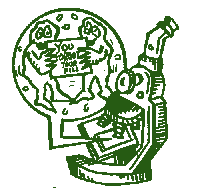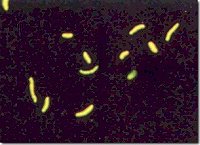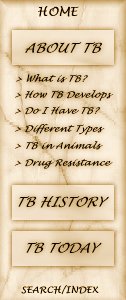
What is Tuberculosis ?
What Causes Tuberculosis ? |
 |
|

|
| Tuberculosis germs are too small to see without a microscope! |
TB is caused by bacteria that belong to a special group of microorganisms called mycobacteria. The species of bacteria that most commonly infect humans is called Mycobacterium tuberculosis complex. Experts call it "MTB" for short. Canadians once developed tuberculosis from a different species also, Mycobacterium bovis. M. bovis is aare bacteria carried by cattle (called "bovine TB"), but this no longer occurs commonly in Canada. People living in other parts of the world may also develop TB from a bacteria called Mycobacteria africanum, but this type is not transmitted in Canada either.
Within this related group of germs called the mycobacteria are several other disease-causing bacteria referred to as "non-tuberculous mycobacteria". For example, the species causing leprosy (Mycobacterium leprae) belongs to this group.
Mycobacteria are long, rod-shaped cells that develop into long chains that look a bit like a string of sausage links when viewed under a microscope. Many bacteria cells are long and slender like this and are known as "bacilli". This is why the tubercle-forming TB bacteria are often called "Tubercle bacilli".

|
| Here is what you see when you look at TB germs under a real microscope. |
Unlike the cells of humans and animals, bacteria have walls around their cells, and the walls of mycobacteria are very special. They are made of 60% "mycolic acid", a special lipid substance that is only found in Mycobacteria, nowhere else. This mycolic acid makes the cells hydrophobic, or resistant to water--an effect that is much like pouring water over a surface that is covered with margarine. This property is important because it once made MTB difficult to stain for identification, and even today lab workers have to use a special technique to distinguish these bacteria.
Mycobacteria are aerobic, which means they like to grow in an environment with oxygen, and MTB like a bit of carbon dioxide as well. Mycobacteria do not like Ultraviolet (UV) rays from the sun. MTB is susceptible to inactivation from UV light and this is the reason why TB patients were once prescribed a sun tansuntan for treatment of their disease.
Like many mycobacteria, MTB is heat-sensitive. This is why the label on your milk carton will saysay, "heat pasteurized". For many years in Canada, milk producers have been required by law to heat all milk to a certain temperature for a specific length of time to kill all mycobacteria present. It is because of this pasteurization process that milk is safe to drink in Canada and other developed countries. If you are travelling to other countries, you need to make sure that any milk you drink is pasteurized or you might risk transmission of bovine tuberculosis.
